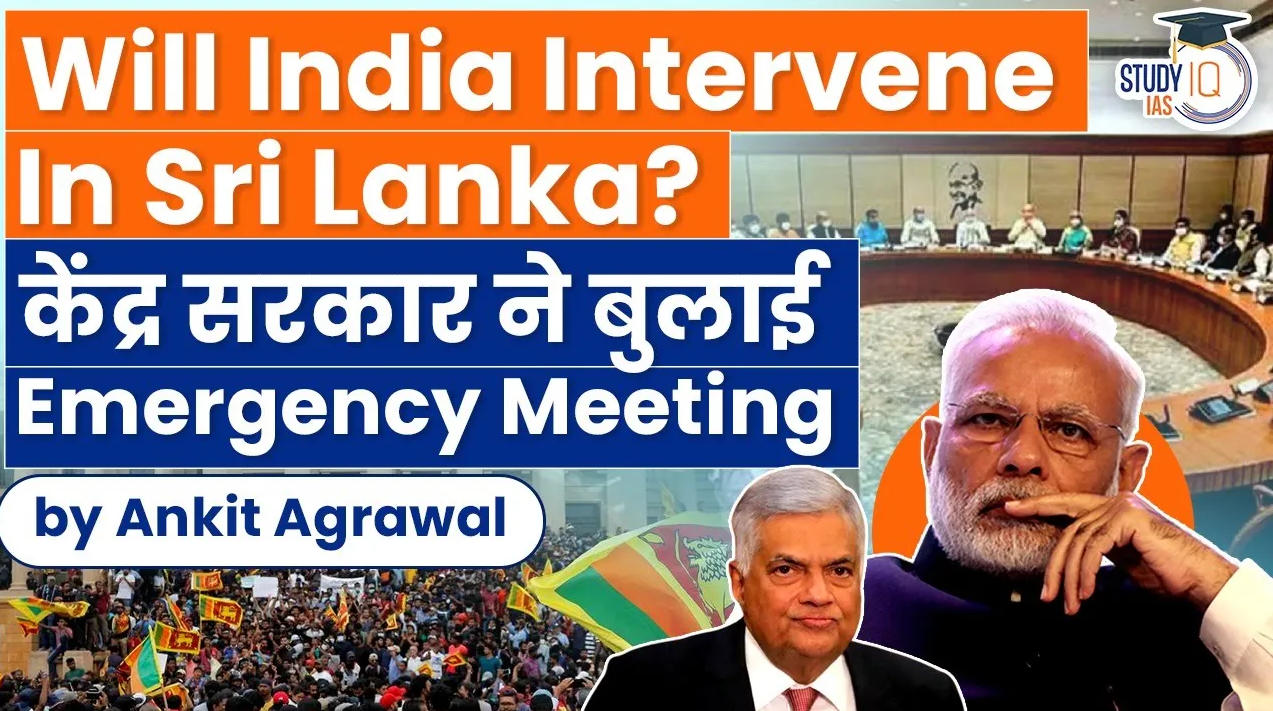Table of Contents
What’s happening?
- An all-party meeting on the turmoil in Sri Lanka has been called on Tuesday evening, with briefings by Union Ministers Nirmala Sitharaman and Dr S Jaishankar,
- The government said on Sunday, following appeals by Tamil Nadu-based parties to intervene in the crisis.
- At a meeting of parties ahead of the Monsoon Session of parliament, the DMK and AIADMK demanded that India intervene in the neighbouring country which is facing its worst economic emergency in seven decades.
- Both parties raised the condition of the country’s Tamil population, M Thambidurai of the AIADMK, which is part of the ruling coalition at the centre, and TR Baalu of the DMK, which governs Tamil Nadu, said.
India’s intervention till now?
- Apart from sending aid via various channels, India has so far maintained a hands-off role in the crisis.
- Last week, in a carefully worded statement, the Ministry of External Affairs said,
- “India stands with the people of Sri Lanka as they seek to realise their aspirations for prosperity and progress through democratic means and values, established institutions and constitutional “
How things turned for India?
- Just a few months ago, Sri Lanka watchers were busy spending ink on declaring India as a sore loser in the race for influence to China.
- But events starting March 2022 have completely changed things and how.
- In March this year, visuals splashed across our TV screens of hundreds of protesters trying to storm into the house of President Gotabaya Rajapaksa demanding his resignation.
- By April 1, an emergency was declared in the nation and within 10 days’ time, food, fuel and medicine shortages started making international headlines.
- On April 12, Sri Lanka officially announced that it is going to default on its external debt of $51 billion.
- This set into motion a series of events where protesters started coming out in the streets of Sri Lanka even as the country sought aid and assistance from world over including other countries and international organisations such as IMF.
- As things stand today, Sri Lankan President Gotabaya Rajapaksa has fled.
- Under Sri Lanka’s constitution, Prime Minister Ranil Wickremesinghe was automatically installed as acting president following Rajapaksa’s resignation,
- And is now the leading candidate to succeed him permanently in a parliamentary vote next week.
So what India is doing?
- Meanwhile, India is focusing on its own security with stepped-up vigil against any influx of refugees or anti-India elements.
- Indian Minister of External Affairs Dr S Jaishankar has also expressed his views that it doesn’t look like Sri Lanka will get into a full-blown refugee crisis, As India’s attempt is to extend economic help to avert such a situation.
- Not just this, the entire way in which India has conducted itself during the Sri Lankan crisis shows that India has really come of age in its neighbourhood diplomacy with a clear sense of purpose and control over key outcomes.
Neighbhourhood policy
- Since the 1990s starting with the Gujral Doctrine of making unilateral concessions to the neighbouring countries for maintaining warm relations with them,
- To PM Manmohan Singh’s outlining of non-reciprocity and asymmetrical benefits for the neighbours, India’s neighbourhood policy has been constantly evolving.
- Under PM Narendra Modi, the ‘Neighbourhood First’ policy has brought a sharp focus on being the first responder, swift diplomatic action and credible commitment by India.
- This was clearly visible in India’s Covid-19 diplomacy.
- In the case of the Sri Lankan crisis, India has emerged as the only country in the world to come to its rescue by giving more than $4 billion as loans, financial assistance and credit line on favourable terms.
- In addition to this, India has also extended food aid and medical aid worth SLR 250 million to Sri Lanka.
- India has also assisted it in approaching the IMF for a bailout.
- Not just this, India is also working on a long-term plan to help the island nation revive its economy.
China’s response
- In contrast, China has said that any help to Sri Lanka is contingent on it showing adequate foreign exchange reserves for three months.
- Sri Lanka also sought a $1 billion loan for procuring essentials from China, but China never got back.
- A $1.5 billion credit-line didn’t materialise either.
- In an interview, Gotabaya Rajapaksa said China is not focused on South Asia anymore but its strategic focus has shifted to South-East Asia and Africa.
- It seems that the Sri Lankan elite overestimated their country’s indispensability to China as the latter sought to become a dominant power in the Indian Ocean.
- But the current economic crisis has exposed Chinese limitations and disinterest and Sri Lanka’s own vulnerabilities.
Conclusion
- In the entire episode, it is India that has emerged as a rising regional power which is also capable of offering ready solutions.
- But it is not an idealist India that considers helping the neighbour as a moral imperative. India is keenly looking out for securing long-term deals in the island country.
- In June, a four-member delegation was sent to Colombo led by Foreign Secretary Vinay Kwatra that discussed investment partnership with Sri Lanka in domains of connectivity, energy, infrastructure, etc.
- India’s timely and meaningful intervention in Sri Lanka in terms of extending help while securing long-term interests,
- That can mutually benefit both the countries shows that its neighbourhood policy is working very effectively.
Q) Which among the following is a warm ocean current of Indian ocean?
- Agulhas current
- Humboldt current
- Canaries current
- Benguela current
Latest Burning Issues | Free PDF

























 WhatsApp
WhatsApp